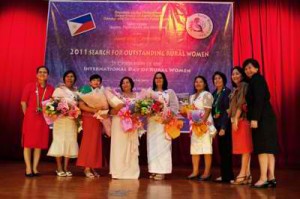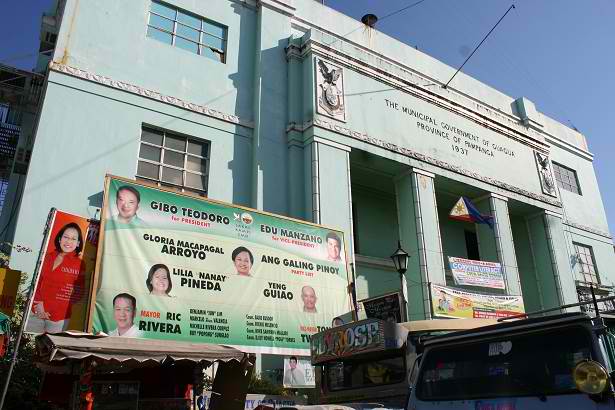By LALA ORDENES
Photos by Mario Ignacio
THEY didn’t have the tsunami walk of Miss Universe third runner-up Shamcey Supsup.Their legs were not as long, their bodies not as lean.
But last Friday, they were the center of an auditorium-full of people. Photographers jostled to capture their every move while admirers waited for their turn for a chance to have a picture with them.
Regal in their Filipiniana, the five women stood on the platform, each with a bouquet of flowers on her right arm, a trophy on her left hand, and a sash wrapped around her body, they all looked like beauty queens in a pageant.
They were the finalists in this year’s 2011 Search for Outstanding Rural Women, to mark the United Nations’ International Day of Rural Women celebrated on October 15 each year.
Organized by the Department of Agriculture Gender and Development Focal System and the Inter-Agency Committee on Rural Women, the award ceremonies was the highlight of a year-long search for “rural women who have excelled in their fields of endeavor and made outstanding accomplishments in developing the agriculture and fishery sector, and making significant impact on the lives of rural folk in their respective communities.”
The five finalists for this year came from various backgrounds, but they have a common attribute: hardworking.
The fourth runner-up, Virginia Dentero-Dureza, comes from Brookespoint, Palawan.
Hers is a classic rags-to-riches story. She worked herself up through farming while taking care of a sick husband. Now she manages 39 hectares of integrated farm with her six children.
An active member of the Rural Improvement Club (RIC), she shares what she knows in food sufficiency farming to the indigenous peoples in her community.
The third runner-up, Marina Tumala-Inapan, is from San Juan, Siquijor.
She has a seven-hectare integrated farm where she promotes alternative staple sufficiency program, or finding alternative food source and substitute food crops for the food self-sufficiency program of government. She is also an official of the Irrigators Association and president of the Rural Improvement Club in her barangay.
Rebecca Castro-Tubongbanua, the second runner-up, is from Buenavista, Guimaras.
Although a Chemistry graduate, she once worked in Hongkong as a domestic helper. When she came back to the country, she started her own business selling calamansi concentrates. Her initial investment was P7,000. Now she owns McNester Food Products which produces processed food products from calamansi, and of course, mango, which her hometown is famous for.
First runner-up Remia Navarro-Apostol is from Koronadal, South Cotabato.
Among the finalists, she is the only one whose educational background is related to agriculture. She is, in fact a graduate of Agriculture. Her husband’s business was failing but through Remia’s efficient management of a five-hectare integrated farm, she was able to pull her family from debt. She is an active member of the women’s association in Koronadal.
The national winner was Myrna Conmigo-Acayen from Goa, Camarines Sur.
At 55, she has been widowed twice. She is engaged in diversified integrated farming and organic agriculture cultivating different crops using indigenous microorganisms. She doesn’t use insecticides and herbicides. Her farm is now home to 50 varieties of palay.
Myrna’s eyes light up when she talks about her farm which gives her an annual income of P200,000.
A high school dropout, she now teaches sustainable farming to other farmers. Just recently, farmers from Sorsogon visited her farm to learn of her best practices.
“My farm has become a showcase for sustainable and diversified farming,” she said.
Aside from the varied plants and crops, she also raises livestock and has a fish pond.
Dentero-Dureza, Tumala-Inapan, Castro-Tubongbanua, Navarro-Apostol and Conmigo-Acayen are just five of the millions of Filipino women who contribute immensely in food production and food security.
Citing figures from the Philippine National Statistics Office, the UN’s Food and Agriculture Organization said women comprised 27.3 percent of the 10.4 million workers employed in the agricultural, hunting and forestry sector.
Yet, rural women’s contribution often goes unnoticed, largely because they “frequently lack the power to secure land rights or to access vital services such as credit, inputs, extension services, training and education.”
To help correct this imbalance, the World Rural Women’s Day was launched by several international non-government organizations during the 4th UN World Conference on Women in Beijing in 1995. Now, it is being celebrated in more than 100 countries around the world.
Women till the land, nurture the environment, and feed their children. And the amazing thing about them, they perform those chores, said Agriculture Secretary Proceso Alcala,” while remaining beautiful.”
Conmigo-Acayen and her co-winners embody those admirable qualities.![]()

